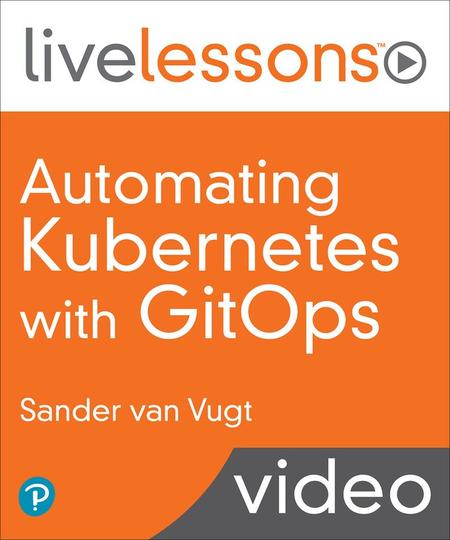
English | MP4 | AVC 1280×720 | AAC 44KHz 2ch | 111 Lessons (7h 40m) | 1.65 GB
Video Instruction Demonstrating How To Use GitOps To Manage Cloud Native Applications
Automating Kubernetes with GitOps is designed to teach you the key concepts on how to automate infrastructure using Gitops. It introduces core topics of DevOps, pipelines and Git and shows how to build images from code in an automated way. You will build on your knowledge of automating infrastructure using Terraform and Ansible and proceed with how to use GitOps operators in a Kubernetes environment and build a custom operator. Finally, you will also learn how to use operators provided by ecosystems, such as Tekton and Argo CD.
Best-selling author and trainer Sander van Vugt uses real-world scenarios and demos throughout so you can see in real time how to use GitOps efficiently and effectively to manage Cloud Native applications.
Topics Include:
- Understanding the Fundamentals teaches the fundamentals by covering DevOps, GitOps and how to work with pipelines.
- From Code to Image teaches how to code from image and goes deeper on creating container images based on the code that you have in Git.
- Automating Infrastructure is about infrastructure automation. It covers how to use infrastructure as code, using Terraform, and about configuration as code, using Ansible.
- From Image to Application is about GitOps and how to advance from running container images to running applications in Kubernetes, accompanied by a short introduction to running applications in Kubernetes.
- Using Kubernetes Ecosystem Solutions covers GitOps solutions that come from the Kubernetes ecosystem including observability, tekton pipelines, and automated code updates.
Learn How To:
- Use DevOps, GitOps, and pipelines
- Build Container Images using Dockerfile
- Run Applications in Kubernetes
- Setup Kubernetes for Gitops
- Build a custom GitOps operator and run it in Kubernetes
- Use advanced Kubernetes solutions to integrate the GitOps operator in Kubernetes
- Use GitOps solutions provided by the ecosystem, such as Argo CD, Jenkins, and Tekton
Table of Contents
Introduction
Automating Kubernetes with GitOps Introduction
Lesson 1 Understanding DevOps and GitOps
Learning objectives
Understanding DevOps
Exploring GitOps
Kubernetes and GitOps
Deploying Everything as Code
DevOps and GitOps Core Components
DevOps Environments
DevOps Stages
Webhooks and Operators
Lesson 2 Using Pipelines
Learning objectives
What is a Pipeline
Creating Pipelines for DevOps
Creating Pipelines for GitOps
Integrating DevOps and GitOps Pipelines
Getting Started with Jenkins
Exploring Pipelines in Jenkins
Lesson 3 Using Git
Learning objectives
Understanding Git
Git Fundamentals
Using Git Advanced Authentication
Working with Branches and Merges
Organizing Git Repositories for GitOps Environments
Lesson 4 Building Container Images
Learning objectives
Understanding Image Formats
Using Dockerfile
Creating a GitOps Container Image
Using Webhooks to Automate Container Image Updates
Lesson 5 Infrastructure as Code
Learning objectives
Understanding Infrastructure as Code
Exploring Terraform
Using Terraform for Infrastructure as Code
Using Terraform to Manage Kubernetes
Lesson 6 Configuration as Code
Learning objectives
Ansible and GitOps
Setting up Ansible
Managing Configuration as Code with Ansible
Setting up AWX
Configuring Webhooks on AWX
Lesson 7 Running Applications in Kubernetes
Learning objectives
Using Kubernetes
Using Minikube
Kubernetes Resources
Running Applications the Declarative Way
Providing Access to Applications
Lesson 8 Setting up Kubernetes for GitOps
Learning objectives
Using NameSpaces to Represent GitOps Environments
Labels and Annotations
Using ConfigMaps to Provide Application Data
Kubernetes Storage
Using Services
Using Ingress
Ingress Access to Services in Specific Namespaces
Using NetworkPolicy to Isolate GitOps Environments
Lesson 9 Controllers and Operators
Learning objectives
Custom Resources
Providing Operator API Access
Understanding Controllers and Operators
Creating a Custom Operator
Lesson 10 Kubernetes CICD
Learning objectives
Understanding Kubernetes GitOps CICD
Implementing a CI Pipeline in Kubernetes
Implementing CD with a Kubernetes GitOps Operator
Lesson 11 Managing Kubernetes Applications the GitOps Way
Learning objectives
Using the Helm Package Manager
Exploring Kustomize
Using Kustomize to Handle Application Updates the GitOps Way
Lesson 12 Using Secrets
Learning objectives
Providing Configuration
Using Secrets
Secrets in GitOps
Bitnami SealedSecrets
Lesson 13 Using GitOps to Provide Zero-downtime Application Updates
Learning objectives
Using Deployment Rolling Updates
Applying BlueGreen Deployment Updates
Using Canary Deployments
Service-based Canary Deployments
Lesson 14 Running a GitOps Project
Learning objectives
Understanding the Project
Preparation Setting up Git
Preparation Creating a Worker Image
Preparation Setting up Storage
Preparation Creating the YAML Files
Implementing the CI Process
Implementing the CD Process
Performing the BlueGreen Application Update
Lesson 15 Implementing Observability
Learning objectives
Understanding Observability
Using Kubernetes Observability Solutions
Using Metrics Server
Using Prometheus
GitOps Observability
Lesson 16 Integrating Tekton Pipelines
Learning objectives
Understanding Tekton Objects
Running Tekton Tasks
Running Tekton Pipelines
Running Tekton Triggers
Lesson 17 Automatically Updating Code to Applications
Learning objectives
Introducing CICD Solutions
Setting up Flux
Using Flux
Exploring OpenShift
Using OpenShift Source to Image
Understanding Argo CD
Using Argo CD
Module 1 Understanding the Fundamentals
Module introduction
Module 2 From Code to Image
Module introduction
Module 3 Automating Infrastructure
Module introduction
Module 4 From Image to Application
Module introduction
Module 5 Using Kubernetes Ecosystem Solutions
Module introduction
Summary
Automating Kubernetes with GitOps Summary
Resolve the captcha to access the links!